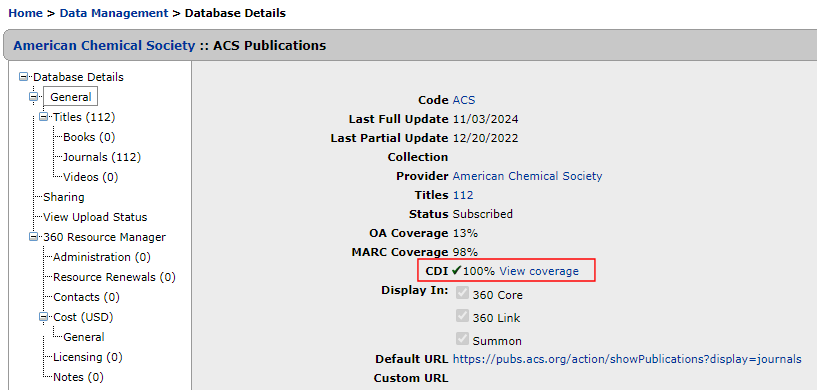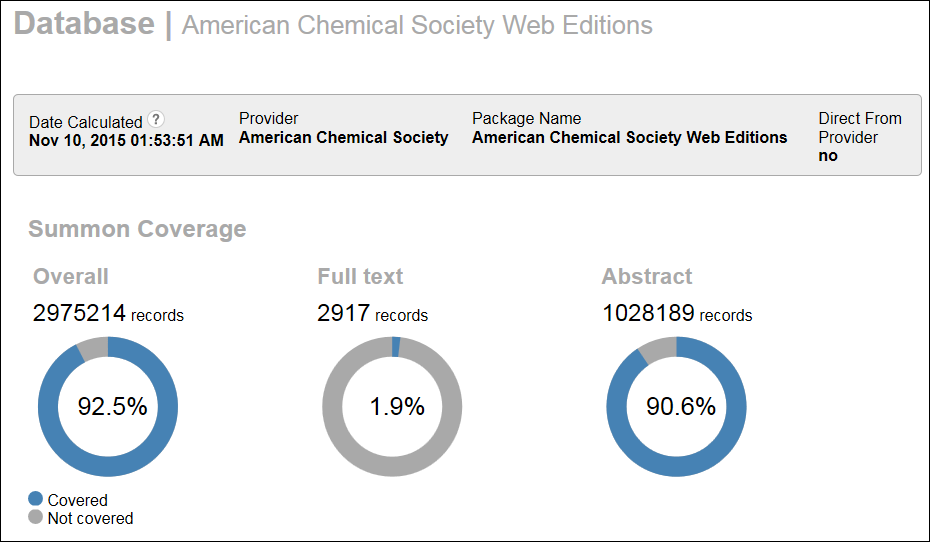Summon: CDI Index Flag
- Product: Summon
What does the CDI Index Flag indicate?
The CDI Index flag (previously called Summon In Index), which displays on the following pages, indicates whether a database is indexed in CDI and also displays the database's coverage percentage in CDI: Client Center's Data Management and Database Details Views and Intota's Database Search and Database Details Views. Databases with a check mark are indexed in CDI.
This flag is available to all Client Center libraries, which do not require a Summon subscription to view the coverage information.
The following figure shows an example of the CDI Index flag in the Data Management View on the Client Center.

The following figure shows an example of the CDI Index flag in the Details View on the Client Center.

For more details regarding the database's coverage, click the View Coverage link to open the Coverage Details View.
Coverage Percentage
The coverage percentage indicates the number of holdings with identifiers (ISSNs or ISBNs) in the database that match identifiers (ISSNs or ISBNs) present on one or more CDI records. A score of less than 100% does not mean that CDI does not completely cover all of the available content for the source. Conversely, a score of 100% does not necessarily mean that CDI has every article of every issue of a given title available in a package. This could be the case for many reasons, such as the following:
-
Our Knowledgebase (KB) may track more titles than are available for discovery—for example, there could be historic titles, alternate titles, split years for titles, and so forth represented that will not match what is in CDI.
-
Our KB may track additional titles that are discoverable in CDI, but the titles do not have identifiers (such as ISSNs or ISBNs) that can easily be matched to the content in CDI for the purpose of this report.
So while a score of 100% is great coverage, so too could be a score of 90%, or 80%, or even 50%. The coverage percentage should always be considered in context with the total number of discoverable titles as well as other factors.
Zero Title Databases do not have title lists in the KB. Coverage is represented as a check mark only, which indicates that the provider package is present in CDI.
-
This list should be used for representative purposes only to explore the breadth and range of content within CDI. It is only a summary of CDI content coverage that is broken down by provider and database package and is derived via a calculation based on identifiers. We will not be able to identify the exact reason why there is less than 100% coverage.
-
Some databases may contain ejournal or ebook holdings in the 360 KB as well as other types of content in CDI (such as streaming audio or musical scores). For content types that do not have title-level rights (which is any type other than ebooks or ejournals), the CDI Index percentage of coverage may not be accurate for the database. In these cases, its percentage of coverage refers only to the coverage for eBook or eJournal content in the index, not the percentage of coverage for the alternate content types (for example streaming audio), which we cannot estimate as a percentage at the present time.
Coverage Details View
The Coverage Details View, which is opened by clicking the View Coverage link in the Details View on either the Client Center or Intota, displays additional metrics on the coverage for the package.
The following figure shows an example of the Coverage Details View on the Client Center.

The following table describes the information that displays in this view.
| Field | Description |
|---|---|
|
Date Calculated |
The date on which the database's data was last updated. The data is updated quarterly. The update begins on the first day of the quarter (January 1, April 1, July 1, and October 1) and can take one to two weeks to complete. |
|
Provider |
The provider of the database. |
|
Package Name |
The name of the database. |
|
Direct from Provider |
Indicates whether the content was acquired directly from the provider.
A large portion of CDI coverage, both metadata and full text, comes via aggregation sources. This does not mean that the quality of the data is necessarily any worse than content that comes directly from the provider/source. |
|
CDI Coverage: |
|
|
Overall |
Based on an identifier match (ISSN or ISBN), the number of records in CDI compared to the number of titles in the Knowledgebase. This is a combination of titles that have full-text, abstract, or citation metadata only included in the record. |
|
Full Text |
Based on an identifier match (ISSN or ISBN), the number of records in CDI with content in the full text field compared to the number of titles in the Knowledgebase. For these titles, CDI searches the full text of the article to aid in determining relevancy. |
|
Abstract |
Based on an identifier match (ISSN or ISBN), the number of records in CDI with content in the abstract field compared to the number of titles in the Knowledgebase. For these titles, CDI searches the abstract field to determine relevancy, so results for these titles will have increased relevance compared to titles for which we only have citation metadata. |
Support Policy
The holdings identifier match information presented in this topic is intended to provide a general overview of available content in CDI. We do not currently have reporting to show which holdings from a database are indexed in CDI.
If a database comes directly from a provider and has coverage below 100%, there are several reasons why that may be the case. For example, it may be caused by a delay between when titles are added to the KB and when they are indexed in CDI (or indicates that there was a delay at the time when the data was being calculated). Or, it could indicate that the holdings are lacking the necessary identifiers to be matched against CDI records. We will not be able to determine the exact reason for cases where coverage is below 100%.
If a database does not come directly from a provider and you would like to request that we explore indexing the content directly from the provider, please enter a request at the Content Ideas Exchange.

